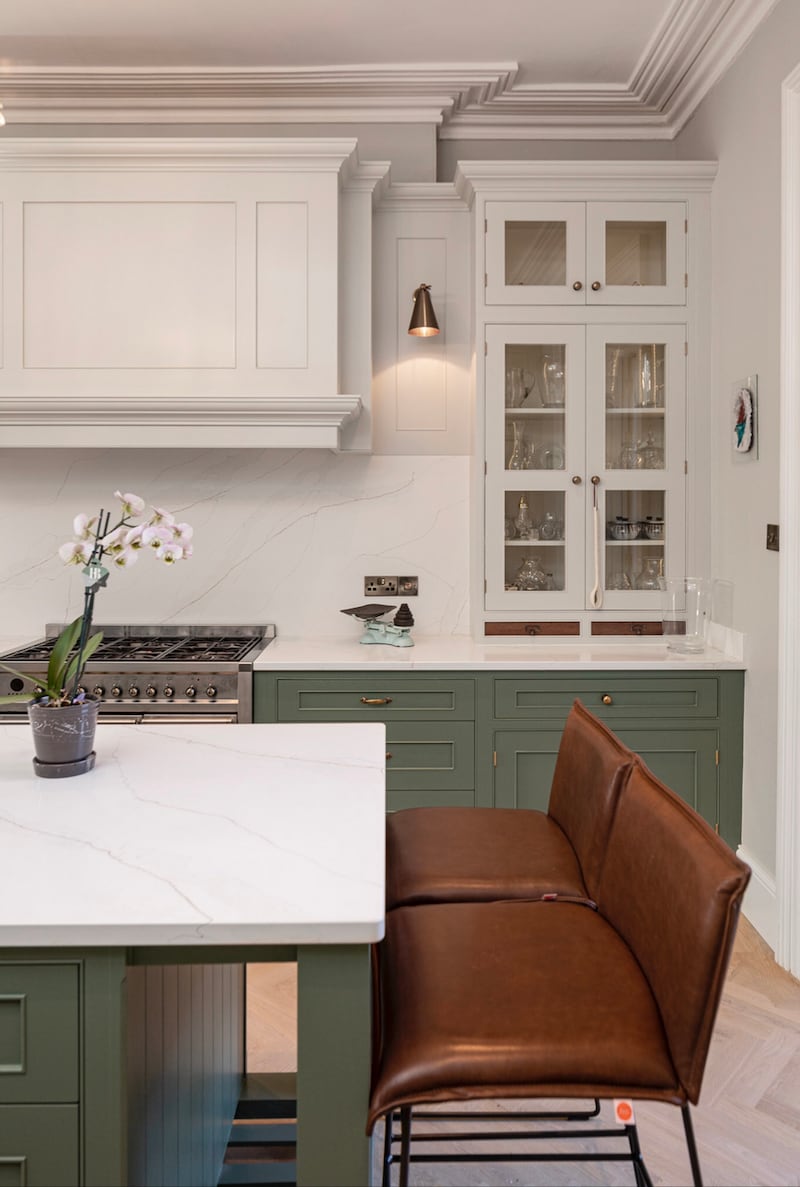In a small survey we carried out last month, 48 per cent of people said they had been planning a kitchen refurbishment project since lockdown. It’s no surprise really. I know my family have been spending a lot more time in our kitchen over the last few months. Now more than ever, this area really is the heart of the home. So investing in it can be really worthwhile and, if done correctly, will add value to your home and enhance your quality of life.
Ed Rhatigan of kitchen-makers Rhatigan & Hick has great advice on what to consider to set yourself up for a successful kitchen makeover.

Layout
When it comes to designing the best kitchen layout, a simple, linear arrangement tends to function better than the more traditional wraparound L-shaped and U-shaped versions.
“Years ago everyone wanted the kitchen table right in the middle of the kitchen and now everyone wants the island there,” says Rhatigan. When accommodating an island in a kitchen design, “your larder and fridge can be at one end, keeping your food storage together. Your cooking zone can be located halfway down with your hob and your ovens together. And your wet area can be located at the end of the run or on the island.”
Avoid corner units if at all possible, he recommends. “Turning corners costs you space and can actually upset the whole flow of the kitchen.” If you’re tight on space but love the idea of an island, a good alternative is to go with a peninsula-type unit instead. “Run a bank of cabinets along the back wall and instead of having a freestanding island connect the peninsula unit to one wall,” he suggests.

Larder presses
Larder presses have become really popular in recent years. “Larders are the oldest and simplest form of storage,” explains Rhatigan. “They were what would have been in kitchens in the 1930s, 1940s and 1950s.”
When it comes to the best use of space in a kitchen, “larder presses are almost a must,” says Rhatigan. A larder that is between 1 and 1.2metres in width will typically give you 30 per cent more storage space than traditional kitchen cupboards. This kind of storage will also do away with the need to store food in less efficient wall units or base presses.
Larder presses can be used to store small appliances such as coffee machines and toasters, which frees up counter space elsewhere in the kitchen. “When you’re efficient with storage, your kitchen doesn’t need to be too big,” says Rhatigan.

Counter tops
There are a lot of options for counter tops, but your choice will depend on your budget and how durable you need the countertop to be. “Our preference for countertops would be quartz,” says Rhatigan. “It’s a really durable material and has become much more natural-looking in the last few years,” he explains.
Marble is a lovely option, “but it is hard to keep,” says Rhatigan, who has marble in his own kitchen at home. “It’s important to be realistic about how you want things to look when choosing your counter top. If you want something to look perfect, quartz is the best choice. If on the other hand, you’re okay with a bit of wear and tear, then marble is a great option.”
If your heart is set on marble but durability is a concern, Rhatigan suggests mixing the two materials. “You can go for a piece of marble as a feature splashback and then choose a complementary quartz on the counter,” he suggests. This way, you get the impact of the natural stone without the worry of looking after it.

Design
When it comes to choosing the style of your kitchen, gathering inspiration from social media sites such as Instagram or Pinterest is a great place to start. But it’s not necessarily the best way to make your final decision. Seeing finishes in situ and being able to compare them next to each other is the only way to really experience the kitchens and see how you feel about them. So try to visit as many showrooms as you can.
“We have a saying in the showroom: see it, like it, buy it,” says Rhatigan. “It’s much easier for people to make a decision when they can see something in reality.
“Don’t be afraid to mix and match styles,” he says. “If you have an Aga you’re not restricted to a traditional-style kitchen.” Similarly, contemporary styles don’t have to be very plain. Your choice of ironmongery and detailing will all add personality. “Replacing clear or frosted glass in a larder press with ribbed glass, for example, will instantly add texture and character,” he says.
Make sure you take the proportions of your space into account when designing your kitchen. “If you have high ceilings, going with standard-height units can make it feel like half the kitchen is missing,” warns Rhatigan. “Similarly, going all the way to the ceiling will make the kitchen feel top-heavy.”
Colour
When it comes to choosing the colour of the kitchen, “the worktop is probably the most critical colour choice”, says Rhatigan. “Dark counters can help to tone everything down whereas bright countertops will lighten everything up.”
Darker colours such as greys, navy and greens are still very popular for kitchens. Pair these with a bright countertop for a lovely contrast. “Flooring and counter tops are hard to change, so choose carefully,” advises Rhatigan. “A hand-painted kitchen can be painted several times over its lifetime so you can have a bit more fun with your colour choice.”
Dual-colour kitchens are also popular. A nice idea is to paint everything dark below the counter top and go light above. Not only is this a really striking design statement, but it also creates the illusion that the space is bigger than it actually is.
















